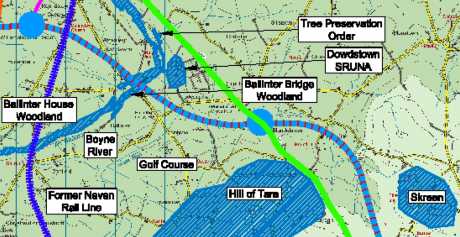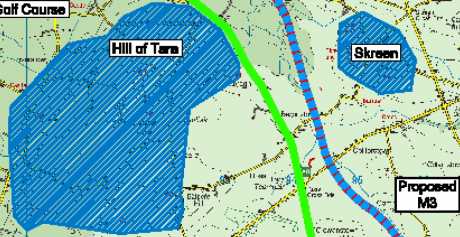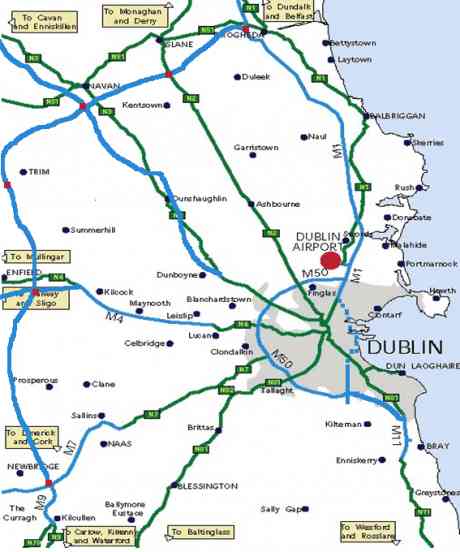Leinster Orbital Route Threatens Hill of Tara
 national |
history and heritage |
news report
national |
history and heritage |
news report  Sunday November 08, 2009 14:25
Sunday November 08, 2009 14:25 by TaraWatch
by TaraWatch info at tarawatch dot org
info at tarawatch dot org
The NRA made a presentation to Meath County Council last week about the Leinster Orbital Route, and one councillor predicted an 'uprising'' in Duleek. WIll there be one at Tara too?
For years now, we have been reading about plans for the Leinster Orbital Route (LOR) or Dublin Outer Orbital Route (DOOR). Earlier this year, the NRA published a Feasibility Report from 2007, which shows route of the LOR passing along the side of the Hill of Tara. Notably, the route goes about 1km north of the Blundelstown Interchange, between the N3 and M3 motorway. However, last week Meath County Councillors were told to freeze planning on a 2km corridor on either side of the route. So, it is possible the route will pass directly through the Blundelstown Interchange, the Hill of Tara complex and the proposed UNESCO World Heritage Site. In fact, it appears that this was the plan all along, and that the route has been chosen before the public consultation even begins.
The National Roads Authority (NRA) has briefed Meath County Councillors on plans for the Leinster Orbital Route (LRO) – a toll road which is proposed to run from Wicklow to County Meath, via County Kildare – and through the heart of the heritage town of Trim, as well as the Hill of Tara complex. A Feasibility Study performed by Roughan & O’Donovan – FaberMaunsell Alliance, as well as Goodbody Economic Consultants, and Tiros – Planning, Sustainable Development and Landscape Consultants, and published in March 2007.
HILL OF TARA
Critically, the proposed route also passes beside the Blundelstown Interchange, the 50 acre spaghetti junction being built on the side of the Hill of Tara, 1000 metres from the top of the Hill. The report indicates that the Blundelstown Interchange was designed and built to facilitate the Outer Orbital Route, even before the LRO was publicly proposed. The route passes through the Hill of Tara complex, as well as the area that would be covered by the proposed Hill of Tara UNESCO World Heritage Site. The Report states:
Major heritage constraints exist at the Boyne Valley complex and the Tara Hill areas in County Meath. Various Special Areas of Conservation (SAC) and Natural Heritage Areas are scattered across the region, with a cluster of SAC’s in the midland bogs of northwest Kildare and east Offaly. In general the route corridor has avoided or skirted these areas.
The report describes the route in detail as follows, in 6.3.2:
Passing south of Navan will require careful route planning, as it will cross the River Boyne near the edge of the urban area and not far from the Tara area, which has a sensitive landscape constraint. The route will cross the proposed M3 motorway in the vicinity of the Navan South Interchange. Provision of a junction between the two routes at this location will require careful design in conjunction with retention of the local road links that are part of the M3 scheme. Due to the other significant constraints in the area, it would be difficult to develop a fully separated junction with the M3 at sufficient separation to the north or south of the Navan junction.
TRIM
The town of Trim is officially designated a heritage town, of approximately 10,000, in the Meath County Development Plan. Yet, the motorway is going to pass through the middle of it. The Feasibility Report states:
Between Navan and Trim the route will stay several kilometres north of the River Boyne Valley so as to avoid important cultural heritage sites and landscape constraints along the river corridor. At Trim there are two route options available. One option is to pass north and west of the town where there are no major constraints as the route crosses predominantly agricultural landscape consisting of medium to large land parcels with some value from hedgerows. Alternatively, the route could turn south and pass east of Trim, but this route would need to keep about 3km downstream of the town so as to avoid several historical sites along the banks of the River Boyne. The landscape south of Trim is predominately rolling hills and lowland. Farming consists of a mix of pastoral and arable farms. Land parcels become larger moving south away from Trim and are often of poor condition with a poor hedgerow structure. The River Boyne will again need to be crossed in a sensitive manner. Although these higher reaches are of lesser landscape value than that found in the Boyne Valley, the river is still of conservation importance. South of the river within the path of the proposed route is Doolystown Bog pNHA.
The Meath Chronicle published the following article on November 4 2009: ‘Uprising’ predicted in Duleek over plans for orbital route:
http://www.meathchronicle.ie/news/navan/articles/2009/1...ments
PLANS for a new 80km motorway – the Leinster Orbital Route – displayed at a Meath County Council meeting this week would be greeted with “an uprising” when it was seen by the people of Duleek and East Meath, a councillor declared. The plans for the road, which would sweep from Drogheda to Slane, Navan, Trim, Kilcock, Naas and Kilcullen, are at an early planning stage and got a heavily qualified welcome from council members. However, serious doubts were raised over the need to keep a 2km-wide corridor of land open while consultations take place over the choosing of a final route for the motorway.
Councillors expressed concern that extensive land masses would be sterilised and out of bounds for development while planning for the motorway went on. Doubts about the plan – shown to members by two senior National Roads Authority (NRA) officials – were raised by Cllr Jimmy Cudden who said that he had viewed them on the internet. He said that he lived in Duleek, where they already had the Irish Cement factory and an incinerator under construction, and it appeared to him that the proposed new motorway would be “squeezed in between the cement factory and the Drogheda-Navan railway line”. But most of his reservations centre on the Commons area of Duleek, “a national heritage area”, and a nearby residential estate, High Meadows. “I am very familiar with the place having driven a coach and delivered children to school from there and there is a very small space between the estate and the railway line”.
“When this plan is seen by the people of East Meath and Duleek I can only envisage that there will be a total uprising on this. This proposal won’t get through”. He said that a 2001 plan for the orbital route had shown that it would “avoid the village of Duleek altogether”. In their presentation to councillors, the NRA officials Nigel O’Neill, senior project manager, Strategic Planning Unit and Hugh Creegan, head of PPP, Commercial Operations and Strategic Planning, said that the plan was supported by the regional planning guidelines, A Platform for Change, Transport 21, National Development Plan 2007-2013. There had been previous studies in 2001-2002, a feasibility study 2006/2007. It had been issued to the Department of Transport in March 2007. There had also been a recent exercise undertaken at likely junction locations to identify possible land protection to preserve viable routes.
The officials were unable to give a cost for the project or project when it might get under way.They said that constraints had been mapped so as to identify potential corridors. There were also significant archaeological constraints on picking a route and there were other topographical, ecological, development and environmental constraints. In deciding the route for the motorway, there were limited options between Navan and Drogheda but more variation in route corridors south of Trim. There would also be a significant challenge in connecting with the M3 at Navan. The officials said that a feasibility study had shown that the orbital route would be beneficial for the region in terms of strengthening links between key development centres, assisting economic development and improving the overall transport network.
After the study had been completed, the officials said, the recommendation of the NRA to the Department of Transport was that the scheme should be progressed to the next stage of development – the preparation of the statutory documentation for the project. Cllr Eoin Holmes said he wanted to know the status of the plan and how the “corridor” for possible routes had been chosen. He said it would be very hard for people to get their heads around the whole project and he would like to have seen a more detailed outline of the route selection process. Cllr Eugene Cassidy raised questions over the possibility of having a 2km-wide corridor preserved along an 80km route. Was it the case that no planning permission could be granted within that 2km corridor, he asked.
Cllr John Farrelly said he believed that more clarity was needed about the plan. They had to be careful that they did not tie up a 2km sweep of countryside while waiting for a final route to be selected. He said that some people had been “very busy” in coming up with a number of drafts up to June 2007 (when the General Election had been held) but they had not heard anything after that from people who were making decisions about the motorway. Council chairman Bill Carey said he hoped that the people of Meath would not be left “dangling on a string” for 10 years awaiting decisions on the motorway. Cllr Joe Reilly said that what they had to do was ensure that the project was included in the National Development Plan. However, they would first have to ask if the project was actually needed. Would they not be better spending money on a public transport system, he asked.
Cllr Brian Fitzgerald said, “What I can see here is a whole stretch of land in Co Meath being tied up for ever and a day”. He also asked if the road would be tolled. Cllr Tommy Reilly said that he had been shouting for 10 years about the need for an outer orbital route. The motorway would “open up the county” and bring development, a regional college, hospitals and industries. He hoped there would be a quick decision on the selection of final route. They had talked about a railway line from Navan to Dublin for 20 years and a local TD, Noel Dempsey had put up the money to get the project under way. One of the NRA officials promised councillors that when the NRA developed up the route process, they would first show it to them before putting it on display to the public.
LINKS – FURTHER INFORMATION
DOR Feasibility Report
http://www.nra.ie/Publications/DownloadableDocumentatio...n.pdf
DOR Maps
http://www.nra.ie/Publications/DownloadableDocumentatio...n.pdf
Department of Transport – Reply to Parliamentary Question on LOR – 28 June 2007
http://www.transport.ie/viewitem.asp?id=9570&lang=ENG&l...=2128
Department of Transport – Reply to Parliamentary Question on LOR – 12 November 2008
http://historical-debates.oireachtas.ie/D/0667/D.0667.2....html
Department of Transport – First Annual Report on the Programme for Government 2007-2012
http://www.taoiseach.gov.ie/attached_files/RTF%20files/...h.rtf
National Roads Authority press release ‘Business Community Warned to be Ready for 2010 or the Roads Will Pass You By! – 17 Oct 2007
http://www.nra.ie/News/PressReleases/htmltext,10779,en.html
Parliamentary Debates – 17 June 2008
https://www.cahill-printers.ie/Debates/DDebate.aspx?F=D...age=5
Parliamentary Debates – Transport Committee – 1 July 2009
http://debates.oireachtas.ie/DDebate.aspx?F=TRS20090701...age=2
Trim Development Plan 2008-2014 – Chapter 7 – Infrastructure
http://www.meath.ie/LocalAuthorities/Publications/Plann...n.PDF
NEW STORIES
Irish Independent – 15 May 2008: €2bn Navan to Newbridge orbital road ‘a top priority’
http://www.independent.ie/national-news/83642bn-navan-t....html
IMAGES
STATEMENT BY NRA
The NRA has now placed the Leinster Orbital Route Feasibility Report onto its website for Public Information
http://www.nra.ie/News/NewsAnnouncements/htmltext,16140....html
Leinster Feasibility Report
The National Roads Authority was charged by Government with the task of carrying out a Feasibility Study in respect of a possible Leinster Orbital Route (formerly known as the Dublin Outer Orbital Route).
The conclusion of the work undertaken has been the identification of a corridor linking Drogheda to Navan to Naas as being the corridor that most closely reflects the ambitions set out in the various policy documents for the region and that best achieves the outcomes required from such a route. The attached document provides an examination of the feasibility of the identified project from a policy, economic, engineering and environmental perspective. Its conclusions can be summarised as:
1. The route is strategically beneficial for the region in terms of strengthening the links between key development centres, assisting the economic development of this centres and improving the overall regional transport network;
2. The route is economically viable. The work done to date indicates that the benefits of the project are significantly greater than the project costs; and
3. The route is technically feasible. While there are numerous constraints throughout the corridor area and adjacent to the corridor, it has been identified that a proper and satisfactory alignment can be developed to deliver the project. In addition, while there are environmental challenges to be addressed there are no environmental issues that would rule out this alignment at this stage of the process.
Arising from the favorable conclusions of the Feasibility Study Report, the Authority recommends that the scheme, which has been retitled as the “Leinster Orbital Route” to reflect the positive impacts of the scheme extending well beyond Dublin, be progressed to the next stage of development – the preparation of the statutory documentation for the project. This would ensure that the scheme would remain protected and would be ready and available for implementation at any stage in the future, when required. In addition, it would prevent new constraints from emerging that would render the project unavailable, or significantly increase its costs, in the future.




